The global tarpaulin sheets market is valued at USD 8,942 million in 2025 and is set to reach USD 15,863.3 million by 2035, growing at a CAGR of 5.9%. The market stands at the forefront of a transformative decade that promises to redefine protective covering infrastructure and weather resistance excellence across construction, agriculture, transportation, and industrial sectors. As reported in Future Market Insights (FMI)’s verified packaging intelligence series, covering sustainability and material lifecycle trends, the market's journey from USD 8,942 million in 2025 to USD 15,863.3 million by 2035 represents substantial growth, demonstrating the accelerating adoption of durable protective solutions and sophisticated weather-resistant systems across building sites, cargo protection, agricultural storage, and emergency shelter applications.
The first half of the decade (2025-2030) will witness the market climbing from USD 8,942 million to approximately USD 11,628 million, adding USD 2,686 million in value, which constitutes 39% of the total forecast growth period. This phase will be characterized by the rapid adoption of heavy-duty covering systems, driven by increasing demand for temporary protection solutions and enhanced durability requirements worldwide. Superior waterproofing capabilities and UV-resistant features will become standard expectations rather than premium options.
The latter half (2030-2035) will witness sustained growth from USD 11,628 million to USD 15,863.3 million, representing an addition of USD 4,245 million or 61% of the decade's expansion. This period will be defined by mass market penetration of specialized tarpaulin systems, integration with comprehensive protection platforms, and seamless compatibility with existing construction and agricultural infrastructure. The market trajectory signals fundamental shifts in how construction companies and agricultural operators approach temporary protection solutions, with participants positioned to benefit from sustained demand across multiple application segments.
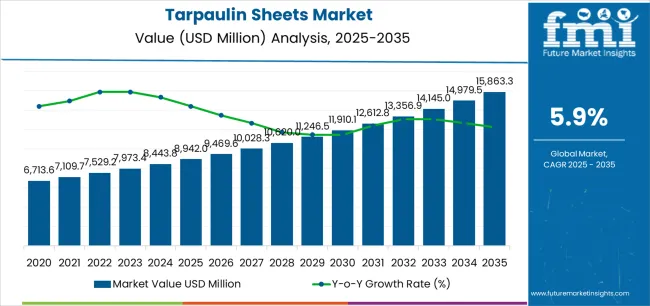
The tarpaulin sheets market demonstrates distinct growth phases with varying market characteristics and competitive dynamics. Between 2025 and 2030, the market progresses through its infrastructure protection adoption phase, expanding from USD 8,942 million to USD 11,628 million with steady annual increments averaging 5.4% growth. This period showcases the transition from standard polyethylene covers to advanced systems with enhanced tear resistance and integrated reinforcement becoming mainstream features.
The 2025-2030 phase adds USD 2,686 million to market value, representing 39% of total decade expansion. Market maturation factors include standardization of tarpaulin specifications, declining material costs for specialty coatings, and increasing contractor awareness of tarpaulin benefits reaching 70-75% effectiveness in construction applications. Competitive landscape evolution during this period features established manufacturers like Sioen Industries and Heytex Brandenburger expanding their product portfolios while new entrants focus on specialized UV-resistant solutions and enhanced waterproofing technology.
From 2030 to 2035, market dynamics shift toward advanced customization and multi-sector deployment, with growth accelerating from USD 11,628 million to USD 15,863.3 million, adding USD 4,245 million or 61% of total expansion. This phase transition logic centers on universal tarpaulin systems, integration with automated deployment equipment, and deployment across diverse application scenarios, becoming standard rather than specialized protection formats. The competitive environment matures with focus shifting from basic material quality to comprehensive durability performance and compatibility with heavy-duty industrial operations.
| Metric | Value |
|---|---|
| Market Value (2025) | USD 8,942 million |
| Market Forecast (2035) | USD 15,863.3 million |
| Growth Rate | 5.9% CAGR |
| Leading Material Type | Polyethylene |
| Primary Application | Construction Segment |
The market demonstrates strong fundamentals with polyethylene systems capturing a dominant share through superior waterproofing and cost-effective manufacturing capabilities. Construction applications drive primary demand, supported by increasing infrastructure development requirements and temporary protection management solutions. Geographic expansion remains concentrated in developed markets with established construction infrastructure, while emerging economies show accelerating adoption rates driven by urbanization projects and rising industrial activity.
The tarpaulin sheets market represents a compelling intersection of protective covering innovation, weather resistance enhancement, and durability management. With robust growth projected from USD 8,942 million in 2025 to USD 15,863.3 million by 2035 at a 5.90% CAGR, this market is driven by increasing infrastructure development trends, agricultural protection requirements, and commercial demand for temporary shelter formats.
The market's expansion reflects a fundamental shift in how construction companies and agricultural operators approach protective covering infrastructure. Strong growth opportunities exist across diverse applications, from construction operations requiring weather protection to agricultural facilities demanding crop storage solutions. Geographic expansion is particularly pronounced in Asia-Pacific markets, led by China (6.8% CAGR) and India (6.5% CAGR), while established markets in North America and Europe drive innovation and specialized segment development.
The dominance of polyethylene systems and construction applications underscores the importance of proven waterproofing technology and tear resistance in driving adoption. Material durability and deployment complexity remain key challenges, creating opportunities for companies that can deliver reliable performance while maintaining operational efficiency.
Market expansion rests on three fundamental shifts driving adoption across construction and industrial sectors. 1. Infrastructure development creates compelling advantages through tarpaulin systems that provide comprehensive weather protection with extended durability, enabling contractors to safeguard materials and equipment while maintaining project timelines and justifying investment over temporary plastic sheeting. 2. Agricultural intensification accelerates as farming operations worldwide seek reliable protection systems that deliver crop preservation directly to storage facilities, enabling harvest protection that aligns with quality standards and minimizes post-harvest losses. 3. Transportation efficiency drives adoption from logistics providers requiring protective covering solutions that maximize cargo safety while maintaining load security during transit and delivery operations.
However, growth faces headwinds from material quality variations that differ across manufacturing sources regarding tear strength and UV resistance, potentially limiting performance reliability in heavy-duty application categories. Disposal infrastructure also persists regarding end-of-life management and material recycling that may increase operational complexity in markets with demanding waste management standards.
Primary Classification: The market segments by material type into polyethylene, PVC, canvas, and polyester categories, representing the evolution from basic plastic sheeting to advanced coated fabrics for comprehensive protection operations.
Secondary Breakdown: Application segmentation divides the market into construction, agriculture, transportation, industrial, residential, and others sectors, reflecting distinct requirements for waterproofing, tear resistance, and weather durability.
Regional Classification: Geographic distribution covers North America, Europe, Asia Pacific, Latin America, and the Middle East & Africa, with developed markets leading innovation while emerging economies show accelerating growth patterns driven by infrastructure development programs.
The segmentation structure reveals technology progression from standard polyethylene sheets toward integrated multi-layer platforms with enhanced durability and protective capabilities, while application diversity spans from construction operations to agricultural facilities requiring comprehensive weather protection and long-term performance solutions.
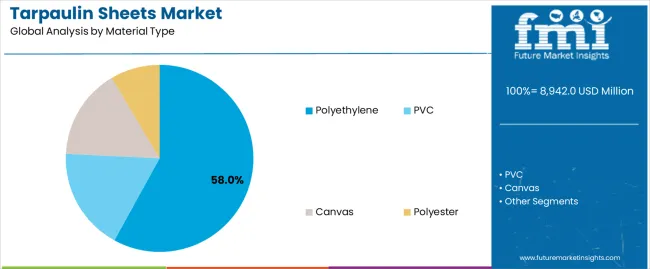
Polyethylene segment is estimated to account for 58% of the tarpaulin sheets market share in 2025. The segment's leading position stems from its fundamental role as a critical component in temporary protection applications and its extensive use across multiple construction and agricultural sectors. Polyethylene's dominance is attributed to its superior waterproofing flexibility, including moisture resistance, lightweight properties, and cost-effective manufacturing that make it indispensable for protective covering operations.
Market Position: Polyethylene systems command the leading position in the tarpaulin sheets market through advanced extrusion technologies, including comprehensive density options, thickness versatility, and reliable weaving performance that enable manufacturers to deploy protective solutions across diverse application environments.
Value Drivers: The segment benefits from contractor preference for proven plastic materials that provide exceptional protection without requiring heavy-duty handling equipment. Cost-effective manufacturing processes enable deployment in construction covering, agricultural protection, and transportation applications where waterproofing performance and affordability represent critical selection requirements.
Competitive Advantages: Polyethylene systems differentiate through excellent water barrier performance, proven lightweight durability, and compatibility with standard fastening systems that enhance protection capabilities while maintaining economical operational profiles suitable for diverse temporary covering applications.
Key market characteristics:
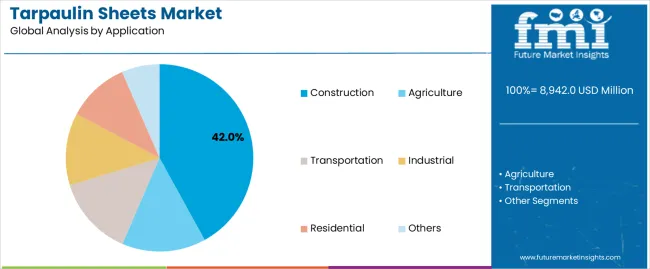
Construction segment is projected to hold 42% of the tarpaulin sheets market share in 2025. The segment's market leadership is driven by the extensive use of tarpaulin sheets in scaffolding protection, equipment covering, temporary roofing, and debris containment, where covering serves as both a protective barrier and weather resistance tool. The construction industry's consistent investment in temporary protection materials supports the segment's dominant position.
Market Context: Construction applications dominate the market due to widespread adoption of protective covering materials and increasing focus on site safety management, equipment protection, and weather-resistant applications that enhance project efficiency while maintaining material quality.
Appeal Factors: Construction companies prioritize weather resistance, tear strength, and integration with scaffolding protocols that enable coordinated deployment across multiple project phases. The segment benefits from substantial safety requirements and building standards that emphasize reliable covering for construction and renovation applications.
Growth Drivers: Infrastructure development programs incorporate tarpaulin sheets as standard protection for building materials and construction equipment. At the same time, construction industry initiatives are increasing demand for temporary covering systems that comply with safety standards and enhance site organization.
Market Challenges: Weather variability and installation complexity may limit deployment flexibility in high-rise construction or extreme climate scenarios.
Application dynamics include:
Growth Accelerators: Infrastructure investment drives primary adoption as tarpaulin systems provide exceptional protective capabilities that enable weather resistance without excessive material investment, supporting equipment preservation and project continuity that require temporary covering formats. Construction expansion accelerates market growth as building contractors seek cost-effective protection solutions that maintain material quality during storage while enhancing site safety through reliable weather barriers. Urbanization increases worldwide, creating sustained demand for temporary covering systems that complement construction projects and provide competitive advantages in contractor operations.
Growth Inhibitors: Quality variation challenges differ across manufacturing regions regarding material consistency and performance specifications, which may limit market penetration and reliability in heavy-duty categories with demanding durability requirements. Installation complexity persists regarding proper securing methods and fastening systems that may increase labor costs in large-scale applications with specialized anchoring standards. Market fragmentation across multiple material types and weight specifications creates compatibility concerns between different deployment methods and existing equipment infrastructure.
Market Evolution Patterns: Adoption accelerates in construction and agricultural sectors where weather protection justifies material investments, with geographic concentration in developed markets transitioning toward mainstream adoption in emerging economies driven by infrastructure development and agricultural modernization. Technology development focuses on enhanced tear resistance, improved UV stability, and integration with automated deployment systems that optimize site protection and equipment safety. The market could face disruption if alternative covering materials or technology innovations significantly challenge tarpaulin advantages in construction applications.
The tarpaulin sheets market demonstrates varied regional dynamics with Growth Leaders including China (6.8% CAGR) and India (6.5% CAGR) driving expansion through infrastructure development and agricultural modernization. Steady Performers encompass the USA (6.2% CAGR), Germany (5.6% CAGR), and Japan (5.3% CAGR), benefiting from established construction sectors and industrial application adoption.
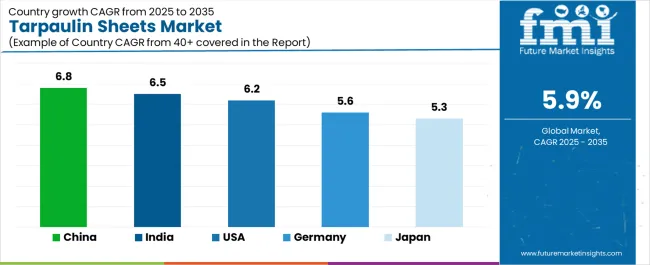
| Country | CAGR (2025-2035) |
|---|---|
| China | 6.8% |
| India | 6.5% |
| USA | 6.2% |
| Germany | 5.6% |
| Japan | 5.3% |
Regional synthesis reveals Asia-Pacific markets leading growth through infrastructure expansion and agricultural development, while European countries maintain steady expansion supported by specialized construction applications and industrial protection requirements. North American markets show strong growth driven by commercial construction and transportation logistics applications.
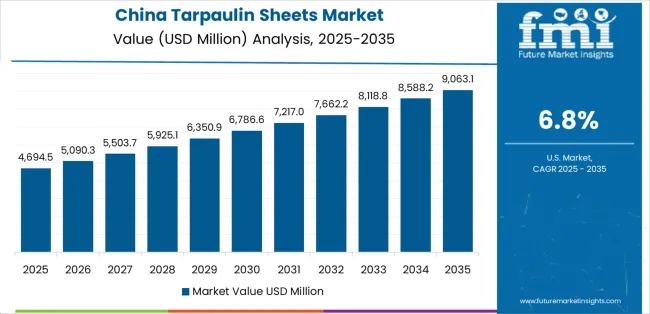
China establishes regional leadership through explosive construction expansion and comprehensive agricultural modernization, integrating advanced tarpaulin systems as standard components in building site protection and grain storage applications. The country's 6.8% CAGR through 2035 reflects government initiatives promoting urban infrastructure and domestic construction activity that mandate the use of protective covering systems in building operations. Growth concentrates in major development regions, including Beijing-Tianjin-Hebei, Yangtze River Delta, and Pearl River Delta, where construction projects showcase integrated tarpaulin systems that appeal to domestic contractors seeking reliable weather protection and international quality standards.
Chinese manufacturers are developing innovative tarpaulin solutions that combine local production advantages with international durability specifications, including heavy-duty reinforcement and advanced waterproofing capabilities.
Strategic Market Indicators:
The Indian market emphasizes construction applications, including rapid infrastructure development and comprehensive agricultural expansion that increasingly incorporates tarpaulin sheets for building protection and crop storage applications. The country is projected to show a 6.5% CAGR through 2035, driven by massive construction activity under government infrastructure programs and commercial demand for affordable, reliable protection systems. Indian construction facilities prioritize cost-effectiveness with tarpaulins delivering weather protection through economical material usage and efficient deployment capabilities.
Technology deployment channels include major construction contractors, agricultural cooperatives, and logistics providers that support high-volume usage for domestic and industrial applications.
Performance Metrics:
The USA market emphasizes advanced tarpaulin features, including innovative coating technologies and integration with comprehensive construction safety platforms that manage site protection, equipment covering, and weather resistance applications through unified protection systems. The country is projected to show a 6.2% CAGR through 2035, driven by commercial construction expansion under infrastructure programs and commercial demand for durable, reliable covering systems. American construction companies prioritize site safety with tarpaulins delivering comprehensive protection through reinforced construction and flame-retardant integration.
Technology deployment channels include major construction contractors, logistics companies, and industrial facilities that support custom development for heavy-duty operations.
Performance Metrics:
In Hamburg, Munich, and Berlin, German construction companies and industrial manufacturers are implementing advanced tarpaulin systems to enhance protection capabilities and support equipment safety that aligns with engineering protocols and quality standards. The German market demonstrates sustained growth with a 5.6% CAGR through 2035, driven by construction innovation programs and industrial facility investments that emphasize reliable covering systems for building and manufacturing applications. German construction facilities are prioritizing tarpaulin systems that provide exceptional tear resistance while maintaining compliance with safety standards and minimizing weather vulnerability, particularly important in scaffolding protection and equipment storage operations.
Market expansion benefits from construction quality programs that mandate protective covering in building specifications, creating sustained demand across Germany's construction and industrial sectors, where durability and material quality represent critical requirements.
Strategic Market Indicators:
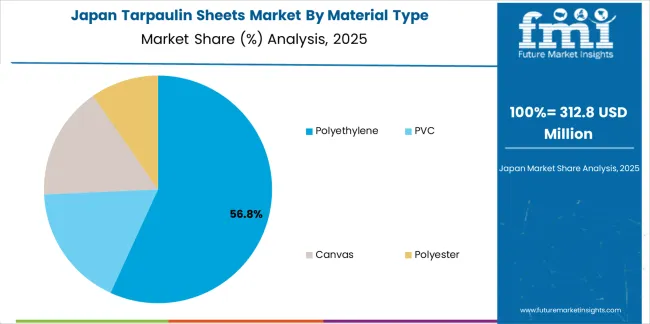
Japan's sophisticated construction market demonstrates meticulous tarpaulin deployment, growing at 5.3% CAGR, with documented operational excellence in building protection and disaster preparedness applications through integration with existing construction systems and quality assurance infrastructure. The country leverages engineering expertise in material science and manufacturing precision to maintain market leadership. Construction centers, including Tokyo, Osaka, and Nagoya, showcase advanced installations where tarpaulin systems integrate with comprehensive scaffolding platforms and safety management systems to optimize site protection and equipment preservation.
Japanese construction contractors prioritize protection precision and material reliability in product development, creating demand for premium tarpaulin systems with advanced features, including seam-sealed construction and integration with typhoon-resistant anchoring protocols. The market benefits from established construction infrastructure and willingness to invest in specialized covering technologies that provide superior weather protection and regulatory compliance.
Market Intelligence Brief:
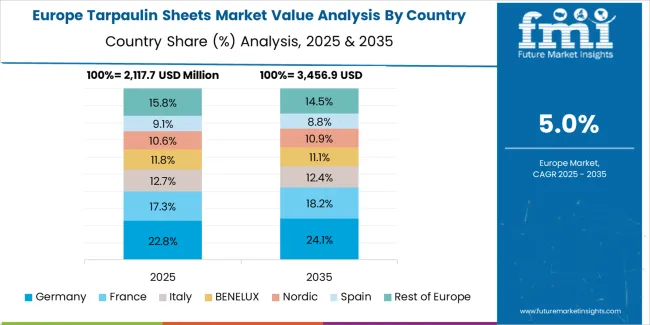
The tarpaulin sheets market in Europe is projected to grow from USD 2,314 million in 2025 to USD 3,782 million by 2035, registering a CAGR of 5% over the forecast period. Germany is expected to maintain its leadership position with a 36.5% market share in 2025, declining slightly to 36.1% by 2035, supported by its construction excellence and major industrial centers, including North Rhine-Westphalia and Bavaria.
France follows with a 24.8% share in 2025, projected to reach 25.2% by 2035, driven by comprehensive agricultural protection and commercial construction initiatives. The United Kingdom holds a 17.6% share in 2025, expected to maintain 17.9% by 2035 through established construction sectors and logistics industry adoption. Italy commands a 10.4% share, while Spain accounts for 8.1% in 2025. The Rest of Europe region is anticipated to gain momentum, expanding its collective share from 2.6% to 3% by 2035, attributed to increasing infrastructure development in Eastern European countries and emerging Nordic construction facilities implementing protective covering programs.
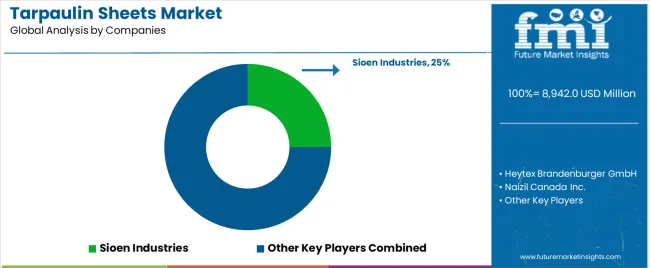
The tarpaulin sheets market operates with moderate concentration, featuring approximately 18-25 participants, where leading companies control roughly 35-42% of the global market share through established distribution networks and comprehensive product range capabilities. Competition emphasizes tear resistance, waterproofing performance, and material durability rather than price-based rivalry.
Market leaders encompass Sioen Industries, Heytex Brandenburger GmbH, and Naizil Canada Inc., which maintain competitive advantages through extensive material expertise, global manufacturing networks, and comprehensive product specification capabilities that create contractor loyalty and support technical requirements. These companies leverage decades of technical textile experience and ongoing coating technology investments to develop advanced tarpaulin systems with exceptional protection and longevity features.
Specialty challengers include Shur-Co LLC, Tarpaulins Direct Ltd, and Polytuf Products, which compete through specialized industrial tarpaulin focus and innovative reinforcement solutions that appeal to construction contractors seeking heavy-duty protection formats and custom sizing flexibility. These companies differentiate through material engineering emphasis and specialized application focus.
Market dynamics favor participants that combine reliable waterproofing performance with advanced customization support, including edge reinforcement and grommet installation capabilities. Competitive pressure intensifies as traditional textile manufacturers expand into tarpaulin systems. At the same time, specialized industrial fabric companies challenge established players through innovative coating solutions and cost-effective production targeting emerging construction segments.
| Item | Value |
|---|---|
| Quantitative Units | USD 8,942 million |
| Material Type | Polyethylene, PVC, Canvas, Polyester |
| Application | Construction, Agriculture, Transportation, Industrial, Residential, Others |
| Regions Covered | North America, Europe, Asia Pacific, Latin America, Middle East & Africa |
| Countries Covered | USA, Germany, Japan, China, India, and 25+ additional countries |
| Key Companies Profiled | Sioen Industries, Heytex Brandenburger GmbH, Naizil Canada Inc., Shur-Co LLC, Tarpaulins Direct Ltd, Polytuf Products |
| Additional Attributes | Dollar sales by material type and application categories, regional adoption trends across North America, Europe, and Asia-Pacific, competitive landscape with technical textile manufacturers and industrial suppliers, contractor preferences for tear resistance and waterproofing excellence, integration with construction equipment and fastening systems, innovations in coating technology and reinforcement construction, and development of specialized protective solutions with enhanced durability and weather resistance capabilities |
The global tarpaulin sheets market is estimated to be valued at USD 8,942.0 million in 2025.
The market size for the tarpaulin sheets market is projected to reach USD 15,863.3 million by 2035.
The tarpaulin sheets market is expected to grow at a 5.9% CAGR between 2025 and 2035.
The key product types in tarpaulin sheets market are polyethylene, pvc, canvas and polyester.
In terms of application, construction segment to command 42.0% share in the tarpaulin sheets market in 2025.






Full Research Suite comprises of:
Market outlook & trends analysis
Interviews & case studies
Strategic recommendations
Vendor profiles & capabilities analysis
5-year forecasts
8 regions and 60+ country-level data splits
Market segment data splits
12 months of continuous data updates
DELIVERED AS:
PDF EXCEL ONLINE
Evaluating Tarpaulin Sheets Market Share & Provider Insights
Mesh Tarpaulin Sheets Market Size and Share Forecast Outlook 2025 to 2035
UV Protected Tarpaulin Sheets Market Size and Share Forecast Outlook 2025 to 2035
Asia Pacific and Europe Tarpaulin Sheets Market Size and Share Forecast Outlook 2025 to 2035
Tarpaulin Sheet Industry Analysis in Western Europe Size and Share Forecast Outlook 2025 to 2035
Tarpaulin Sheet Industry Analysis in Korea Size and Share Forecast Outlook 2025 to 2035
Tarpaulin Sheet Industry Analysis in Japan Size and Share Forecast Outlook 2025 to 2035
Hoarding tarpaulin Market
Slip Sheets Market Insights – Growth & Demand 2025 to 2035
Dryer Sheets Market Size and Share Forecast Outlook 2025 to 2035
Veneer Sheets Market Size and Share Forecast Outlook 2025 to 2035
Mirror Sheets Market Size and Share Forecast Outlook 2025 to 2035
Aluminum Sheets and Coils Market Size and Share Forecast Outlook 2025 to 2035
Greaseproof Sheets Market Size and Share Forecast Outlook 2025 to 2035
Replacement Sheets Market Analysis - Size, Share & Forecast 2025 to 2035
Market Share Insights for Greaseproof Sheets Providers
Cast Acrylic Sheets Market Size and Share Forecast Outlook 2025 to 2035
TPE Films and Sheets Market Size and Share Forecast Outlook 2025 to 2035
Push-Pull Slip Sheets Market Size, Share & Forecast 2025 to 2035
Disposable Bed Sheets Market Analysis - Trends, Growth & Forecast 2025 to 2035

Thank you!
You will receive an email from our Business Development Manager. Please be sure to check your SPAM/JUNK folder too.
Chat With
MaRIA